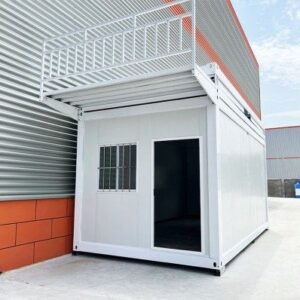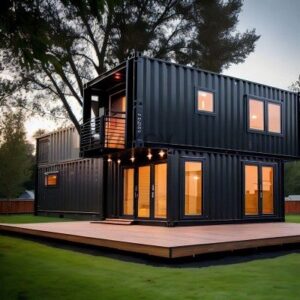What Are Shipping Container Homes Definition and Types
Shipping container homes are residences built primarily from steel shipping containers originally designed for transporting goods. These containers serve as modular building blocks that can be adapted into comfortable, functional living spaces. The most common types used in container housing are standard 20-foot and 40-foot containers, including 40-foot high cube containers, which offer extra height for added interior space.
- 20-foot containers measure roughly 160 square feet, ideal for compact homes or additional rooms.
- 40-foot containers provide about 320 square feet of floor space and are popular for single-container homes.
- 40-foot high cube containers add nearly one extra foot of vertical space, improving ceiling height and usability.
These containers are structurally strong, weather-resistant, and stackable, making them versatile for various construction needs.
Common Uses of Containers in Residential Construction
In residential construction, shipping containers are used in several creative and practical ways:
- Single or multi-container homes stacked or placed side-by-side to create larger floor plans.
- Tiny homes or accessory dwelling units (ADUs) benefiting from quick setup and affordability.
- Modular expansions to existing homes, functioning as extra rooms, studios, or home offices.
- Off-grid or disaster relief housing, where portability and durability are key.
Their modular nature allows for flexible design, from minimalist tiny homes to complex multi-level houses.
Advantages and Limitations Regarding Costs and Design
Advantages
- Cost efficiency: Containers can be more affordable than traditional building materials, especially when using used containers.
- Speed of construction: Prefabricated boxes reduce build time significantly.
- Durability: Built for harsh ocean conditions, containers withstand weather and structural stress.
- Modularity: Easy to stack or combine for customized layouts.
- Eco-friendly: Repurposing used containers reduces waste and environmental impact.
Limitations
- Design constraints: Fixed width (typically 8 feet) limits interior space, requiring creative layout solutions.
- Insulation and ventilation: Steel conducts heat and cold, making proper insulation and climate control crucial—these add to costs.
- Structural modifications: Cutting for windows, doors, and openings needs careful engineering to maintain strength, increasing customization expenses.
- Permitting challenges: Some jurisdictions have restrictions or special building codes for container homes, affecting project timelines and costs.
Cost of Buying Shipping Containers for Building Houses
When planning a container home, the cost of shipping containers is one of the first big numbers to consider. Prices vary widely based on condition, size, and where you buy them, so understanding these factors helps you budget smarter.
Average Price Range of Containers for Homes
- Used Containers: Typically range from $1,500 to $3,000 for a standard 20ft container. Used containers often have some wear but still provide a solid base for construction if selected carefully.
- New Containers: Generally cost $3,000 to $5,000+ for a 20ft box. New containers are cleaner and longer-lasting but come at a higher price.
- Larger 40ft or 40ft high cube containers usually add $1,000 to $2,000 more compared to 20ft units, depending on demand.
Regional Price Variations
Container prices fluctuate depending on your location in the U.S. For example:
- West Coast and port cities (like Los Angeles and Seattle) usually offer better prices due to easy container access.
- Inland or remote areas often see higher costs because of delivery and limited supply.
Key Factors Affecting Container Prices
- Condition: “One-trip” or lightly used containers cost more but have fewer repairs. Rusty or damaged ones are cheaper but might add to modification costs.
- Size: 20ft containers are less expensive but offer smaller living space. 40ft and high cube containers provide more room at a higher cost.
- Location and Demand: High demand or limited supply in your area can drive prices up.
- Market Trends: Fluctuations in shipping and steel markets can affect prices. Keep an eye on supply chain changes.
Where to Buy Shipping Containers for a House
- Local Suppliers and Dealers: Often sell used and new containers with inspection options.
- Ports and Shipping Yards: May offer containers at competitive prices but often without warranty.
- Online Resale Markets: Platforms like Craigslist, Facebook Marketplace, or specialized container retailers.
- Container Home Specialists like Yichen provide sourcing services with quality checks and fair pricing, saving you time and headache.
Yichen’s Recommended Sourcing Tips for Quality Containers
- Inspect the container thoroughly or hire an expert to check for structural integrity and rust.
- Choose containers with minimal damage to reduce repairs.
- Opt for “high cube” containers if you want more headroom without larger footprints.
- Work with trusted suppliers who can deliver right to your site to avoid extra shipping fees.
- Consider bundled deals or packages that include modifications to save costs later.
For more detailed guidance on container prices and sourcing, visit how much is it to build a container house or explore our container options at Yichen Container House.
Additional Costs Beyond the Container Purchase for Container Home Construction
When planning your shipping container home cost breakdown, remember the price of the container itself is just the start. Several container home construction expenses add up and can impact your overall budget.
Site Preparation and Foundation
Before your containers arrive, the land needs work:
- Land clearing and grading to level the site
- Installing a foundation: slab, pier, or crawl space options depending on soil and local codes
- Preparing access roads if needed for delivery equipment
These steps are crucial and vary widely depending on your location and lot conditions.
Shipping and Delivery Fees
Transporting containers from ports or suppliers to your build site is another cost factor:
- Fees depend on the distance between the port and your site
- Accessibility can hike costs—if your site is rural or tough to reach, expect more
- Local regulations might require special permits for oversized loads
Plan for shipping, handling, and unloading expenses when budgeting.
Modifications and Customization
To make the container livable, significant changes are needed:
- Cutting and welding for doors, windows, and interior connections
- Installing insulation to handle weather and climate inside
- Adding doors and windows to meet design and light requirements
These modifications impact cost and timeline significantly, especially if you want a polished look.
Interior Fit-Out
After the shell, your container needs a full interior setup:
- Plumbing and electrical wiring installations
- Drywall or wall paneling for insulation and aesthetics
- Flooring materials like wood, laminate, or tile
- Fixtures including lighting, cabinets, and bathroom/kitchen essentials
All these add up and require skilled labor, raising your construction expenses beyond just the container.
Permits and Approvals
Building a container home means dealing with local rules:
- Obtaining building permits and zoning approvals
- Meeting local building codes and inspection requirements
- Possible fees for plan reviews and project inspections
This process varies by state and city and shouldn’t be overlooked in your budget.
Utility Hookups
Finally, connecting your container home to utilities costs money:
- Hooking up water, electricity, and sewage to the municipal systems or alternatives
- In remote areas, installing septic tanks or well water systems may be necessary
- Solar or other off-grid setups can be an option but require upfront investment
These charges are ongoing but require upfront setup costs included in your container home budget planning.
Typical Breakdown of How Much Are Containers To Build A House
When thinking about how much are containers to build a house, it’s important to understand that buying the containers themselves is just one part of the entire budget. Here’s a typical breakdown based on a 2-container home example, which is a popular size for a small to medium living space:
| Cost Component | Estimated Percentage of Total Cost | Approximate Cost Range* |
|---|---|---|
| Shipping Containers | 30% | $8,000 – $12,000 |
| Construction & Modifications | 40% | $10,000 – $16,000 |
| Interior Finishing & Utilities | 30% | $8,000 – $12,000 |
*Prices vary widely by region and project scale.
Containers vs Construction and Modification Costs
- Containers: The starting point is purchasing 2 standard containers (usually 20ft or 40ft high cubes). Used containers typically cost less but may need more repairs.
- Construction & Modification: This includes cutting the containers to add windows and doors, welding for structural support, adding insulation, and ensuring the structure meets local building codes.
- Interior Fit-Out: Plumbing, electrical work, drywall, flooring, and fixtures often add up quickly and are just as crucial for comfort.
Comparing Modular Container Homes with Traditional Homes
- Container homes often save on material costs since the structure is pre-made, reducing framing expenses.
- However, modification and finishing costs can be higher than a traditional home because containers require special work (like insulation and cutting).
- On average, container homes cost between $150 and $300 per square foot, which can be competitive with traditional homes, especially when factoring in faster build times.
- Traditional homes usually have more flexibility in design but can take longer to build and might come with higher labor costs.
Practical Insights
- The container purchase is roughly 30% of your total budget, so don’t only focus on the container price.
- Plan carefully for modifications because they’re the largest chunk of your budget.
- Interior work and utilities are critical and often underestimated; allocate at least 25-30% of your budget here.
Cost Saving Tips When Building Shipping Container Homes
Building a container home can be affordable, but smart choices make a big difference in your container home construction expenses. Here’s how to save without compromising quality.
Buy Used vs New Containers Wisely
- Used Containers: Typically cost less, often between $1,200 and $3,000 for a 20ft container depending on condition and location. Perfect if you’re on a tight budget but expect some repairs and modifications.
- New Containers: Can cost $3,000 to $5,000 or more but come in excellent shape with fewer structural issues.
- Consider the price of containers for building houses local to your region to reduce shipping fees. You can check local ports and suppliers for competitive rates.
- When buying used, inspect carefully for rust, holes, or structural damage that could increase overall costs later.
DIY Work vs Professional Contractors
- Doing some of the work yourself (cutting, welding, or interior finishing) can dramatically lower costs.
- But don’t underestimate the skill and time required—some parts like electrical wiring and permits need licensed pros.
- Mix DIY with professional help to keep expenses balanced while ensuring safety and compliance.
Use Minimalist Designs to Reduce Expenses
- Simple, compact layouts lower the number of containers and modifications needed.
- Avoid complex structural changes which add to your container home modification costs.
- Open-plan designs with fewer internal walls reduce materials and labor costs.
Leverage Local Materials and Labor
- Sourcing materials locally cuts down transportation fees and often supports small businesses.
- Use Yichen’s recommended resources for affordable, quality local options, including contractors and suppliers familiar with container projects.
- Local expertise also helps speed up work and navigate zoning and permits efficiently.
These strategies will help stretch your budget and manage the overall container house budget planning better, making your container home project more affordable and manageable.
For more detailed cost breakdowns and buying tips, see How Much Do Container Houses Cost.
How Much Are Containers To Build A House
When building a container home, unexpected expenses can easily pop up and throw off your budget. Being prepared for these surprises is key to keeping your project on track.
Common Unexpected Expenses in Container Home Projects
- Repairs and Damage: Containers might look solid, but you could uncover rust, dents, or structural issues once work begins.
- Design Changes: Mid-project tweaks to the layout or features can add labor and material costs.
- Permit Delays and Additional Fees: Local building codes for container homes can be tricky. If permits take longer or extra inspections are required, expect added expenses.
- Site Issues: Unseen soil problems, drainage challenges, or need for extra grading can increase site prep costs.
- Material Cost Fluctuations: Prices for steel, insulation, or finishing materials can rise unexpectedly during construction.
Tips for Setting Up a Contingency Fund
- Set Aside 10-20% of Your Total Budget: This buffer covers most surprises without stalling the project.
- Keep Documentation Updated: Track all changes and delays to justify extra spending if needed.
- Prioritize Flexibility: Choose contractors and suppliers open to changes without hefty penalties.
- Review Permitting Requirements Early: Knowing your local zoning and inspection process helps avoid last-minute fees or work.
- Stay Involved: Regularly check progress to spot problems early before they turn costly.
By planning for these unexpected container home construction expenses, you maintain control over your budget and reduce stress throughout your build.
Financing Your Container Home Construction and Costs
Building a container home requires more than just buying containers and modifying them. Securing proper financing is a key step that many overlook. Fortunately, there are several loan options, grants, and incentives designed for alternative and affordable housing projects like container homes.
Loan Options for Container Home Builders
Traditional mortgages can be tricky with container homes since they don’t fit the usual construction or prefab home models lenders are familiar with. However, some financing routes to consider include:
- Construction loans: These cover the building phase and convert to permanent loans once your home is complete. They often require a solid plan and builder experience.
- Personal loans: A viable short-term option if your budget is small, with fewer restrictions but higher interest rates.
- FHA 203(k) loans: These government-backed loans support homes under renovation, including container home conversions, if they meet local codes.
- Home equity loans or lines of credit: If you own property, these can be good funds sources at lower rates.
- Specialized lenders: Some banks and credit unions now work with alternative housing projects and understand container home specifics.
Grants and Incentives for Container Homes
Some states and municipalities encourage affordable and sustainable building by offering:
- Green building grants: Financial support for energy-efficient container homes.
- Tax incentives: For projects using recycled materials or meeting sustainable practices.
- Local housing grants: Often available for alternative, low-cost housing developments.
Make sure to research state and city programs, as these vary widely across the U.S.
Working with Lenders Familiar with Container Homes
Why is this important? Lenders experienced with container home construction understand your project’s unique costs and timelines. They’re more likely to approve your loan and offer appropriate terms. Here’s how to find them:
- Look for lenders who advertise alternative housing loans or have previously financed container or tiny homes.
- Consult builders and container home companies — they often have financing partners.
- Prepare a detailed project plan including budget, site plans, and contractor info to present a clear picture of your build.
By partnering with the right lender, you reduce financing headaches and get better odds at funding your container home dreams.
For a deeper dive into building costs and financing, check out How Much Is It to Build a Container House.
Why Choose Yichen for Your Container Home Project
When it comes to building a shipping container home, choosing the right partner can make all the difference. Yichen stands out as a trusted expert, specializing in container homes tailored for the US market. Here’s why Yichen is the go-to choice for many looking to build affordable, durable, and stylish container homes.
Expertise in Container Home Construction and Design
Yichen has years of experience sourcing and customizing shipping containers for residential use. We understand the unique challenges and opportunities of container home construction, from design to delivery. Our team ensures that every project meets local building codes and zoning laws, so your home is both legal and safe.
Comprehensive Services from Sourcing to Project Management
We offer a full suite of services to streamline your container home project, including:
- High-quality container sourcing: We help you find the right container, whether 20ft, 40ft, or high cube, new or used, at competitive prices.
- Design and customization: Our designers work with you to create functional and attractive floor plans customized to your needs.
- Modifications and fit-outs: From cutting windows and doors to insulation and interior finishing, we handle all structural modifications.
- Project management: We coordinate shipping, site preparation, installation, and compliance with building permits and inspections.
Proven Track Record with Satisfied Clients
Many homeowners have turned their ideas into reality with Yichen’s help. Client success stories highlight how our affordable container homes combine quality with budget-conscious solutions. Testimonials frequently praise our professionalism, timely delivery, and attention to detail.
Value for Your Container Home Investment
Choosing Yichen means you get expert guidance that keeps your costs manageable while maximizing value. Whether you’re building a tiny container house or a multi-container family home, we offer clear pricing and transparent cost breakdowns, helping you avoid common pitfalls and unexpected expenses.
For more detailed information on costs and construction, check out these guides:
With Yichen, building a container home is straightforward, affordable, and tailored precisely for your needs



